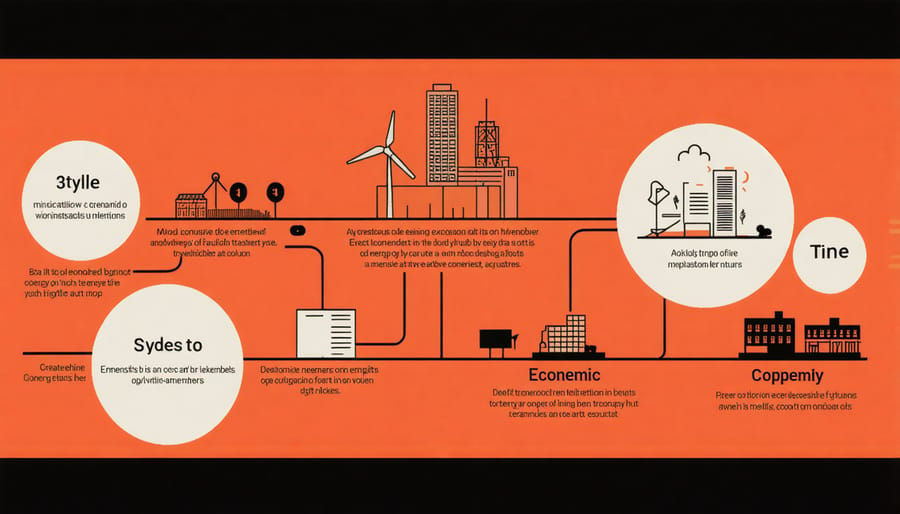Cooperative principles revolutionize how businesses operate, driving the community solar power revolution and reshaping sustainable enterprise models worldwide. These seven foundational guidelines—voluntary membership, democratic control, economic participation, autonomy, education, cooperation among cooperatives, and community concern—form the backbone of successful cooperative ventures across industries. Originally established by the Rochdale Society in 1844, these principles have evolved into powerful tools that enable organizations to balance profit with purpose, creating resilient business structures that benefit both members and communities. Today, as businesses increasingly prioritize sustainability and social responsibility, these cooperative principles offer a proven framework for building economically viable enterprises that generate lasting social impact. From energy cooperatives transforming local power generation to agricultural co-ops revolutionizing food systems, these principles demonstrate how collective action and shared ownership can drive innovation while ensuring equitable distribution of benefits among stakeholders.
Voluntary and Open Membership in Action

Case Study: Success Through Open Doors
The Rural Electric Cooperative (REC) of Green Valley stands as a shining example of the open membership principle in action. Established in 2015, this energy cooperative grew from 500 to over 15,000 members in just five years by maintaining an inclusive membership policy that welcomes all residents within its service territory. The co-op’s success stems from its transparent application process and reasonable membership fee of $100, which can be paid in installments. This approach has enabled diverse participation, including low-income households and small businesses. The cooperative now generates 60% of its power from community solar installations and has reduced energy costs for members by an average of 25%. Through its open-door policy, REC of Green Valley has not only achieved financial sustainability but also created a model for inclusive community-owned energy systems.
Democratic Member Control
Community Voice in Action
In successful solar cooperatives, democratic member control takes shape through structured community engagement processes. The South Mountain Solar Project in Vermont demonstrates this principle through quarterly town hall meetings where members vote on project expansions and rate structures. Similarly, the Midwest Renewable Energy Cooperative implements a digital voting platform, allowing members to participate in decisions about equipment upgrades and maintenance schedules remotely. These cooperatives typically establish working groups where members with technical expertise collaborate with community representatives to evaluate proposals and make recommendations. Project managers report that this inclusive approach, while requiring more coordination initially, results in higher member satisfaction and smoother project implementation. The model has proven particularly effective in addressing local concerns about land use and ensuring fair distribution of benefits among cooperative members.

Members’ Economic Participation
ROI Analysis
Energy cooperatives consistently demonstrate impressive returns on investment for their members. Studies show that participants in community solar projects typically save 10-15% on their annual energy costs through shared ownership and smart energy integration. Beyond individual savings, these cooperatives generate substantial community benefits. For example, the Midwest Energy Cooperative reported $2.3 million in member dividends in 2022 while investing $500,000 in local community development projects. Similarly, rural electric cooperatives have created over 130,000 jobs nationwide while maintaining energy costs 13% lower than investor-owned utilities. These tangible benefits demonstrate how cooperative principles translate into measurable economic and social returns for both members and their communities.
Autonomy and Independence
Energy cooperatives maintain their autonomy while fostering strategic partnerships through careful governance structures and clear operational boundaries. This independence enables co-ops to prioritize member interests while leveraging external relationships for growth and innovation.
A key aspect of maintaining autonomy is financial independence. Successful energy co-ops establish sustainable business models that generate sufficient revenue through member investments and energy sales. This financial self-reliance allows cooperatives to make decisions based on member needs rather than external pressures.
In practice, energy co-ops often collaborate with utility companies, technology providers, and government agencies while maintaining decision-making authority. For example, the Midwest Energy Cooperative partners with grid operators for power distribution while independently managing its community solar programs and member services.
Democratic member control reinforces this independence. Members elect boards of directors who negotiate agreements with external entities, ensuring that partnerships align with cooperative values and member interests. This governance structure prevents outside influence from compromising the co-op’s mission.
Technical partnerships present both opportunities and challenges for maintaining autonomy. Co-ops often work with equipment manufacturers and maintenance providers while retaining control over system specifications and operational decisions. The key is establishing clear contractual boundaries that preserve the cooperative’s authority over core functions.
Energy co-ops demonstrate that independence and collaboration can coexist effectively when guided by strong governance principles and member-focused decision-making processes.
Education, Training, and Information
Education and training form the cornerstone of successful cooperative operations, ensuring all members understand their roles, rights, and responsibilities within the organization. Cooperatives actively invest in developing their members’ knowledge through structured programs, workshops, and continuous learning opportunities.
Member education programs typically cover fundamental aspects such as cooperative governance, financial literacy, and operational best practices. These initiatives help members make informed decisions about their cooperative’s direction and effectively participate in democratic processes. For example, energy cooperatives often provide training on renewable energy technologies, energy efficiency practices, and sustainable resource management.
Beyond member education, cooperatives play a crucial role in raising awareness about the cooperative model within their communities. They engage with local organizations, educational institutions, and government bodies to demonstrate the benefits of cooperative enterprises. This outreach helps attract new members while fostering community support and understanding.
Information sharing is facilitated through various channels, including regular newsletters, digital platforms, and member meetings. Cooperatives maintain transparency by providing clear, accessible information about their operations, financial performance, and strategic initiatives. This commitment to open communication strengthens member trust and engagement.
Many cooperatives also develop mentorship programs, pairing experienced members with newcomers to facilitate knowledge transfer and maintain organizational continuity. These relationships help preserve institutional knowledge while fostering innovation and adaptation to changing market conditions.
Cooperation Among Cooperatives
In the energy sector, cooperation among cooperatives has become a cornerstone of sustainable growth and operational efficiency. Energy cooperatives regularly collaborate to share resources, technical expertise, and best practices, creating robust networks that enhance service delivery and reduce costs for members.
A prime example is the Northeast Energy Cooperative Alliance (NECA), where multiple rural electric cooperatives pool their resources for bulk purchasing of equipment and shared emergency response systems. This collaboration has resulted in a 23% reduction in operational costs and improved service reliability across participating cooperatives.
Energy cooperatives also engage in knowledge transfer partnerships. The Midwest Renewable Energy Cooperative Network demonstrates this through its shared training programs and technical assistance initiatives. Member cooperatives contribute to a collective knowledge base, enabling smaller cooperatives to access expertise and resources typically available only to larger utilities.
Infrastructure sharing represents another vital aspect of cooperative collaboration. The Western Grid Initiative showcases how multiple energy cooperatives can jointly invest in transmission infrastructure, spreading costs and risks while expanding renewable energy capacity. This partnership model has enabled participating cooperatives to increase their solar and wind power integration by 45% over five years.
These collaborative efforts extend beyond regional boundaries through international partnerships. Many U.S. energy cooperatives participate in development programs, sharing technical expertise with emerging cooperatives in developing nations, fostering global sustainable energy development while strengthening the cooperative movement worldwide.
Concern for Community
Measuring Community Impact
Successful cooperatives regularly assess their community impact through quantifiable metrics and tangible outcomes. Key performance indicators include job creation, local economic growth, and environmental impact on urban communities. For example, energy cooperatives often track reduced carbon emissions, number of households served, and cost savings delivered to members. Many cooperatives report annual community benefit statements, showcasing reinvestment in local infrastructure, educational programs, and sustainable development initiatives. Success stories frequently highlight improved energy access in underserved areas, enhanced grid reliability, and increased adoption of renewable energy solutions, demonstrating how cooperative principles translate into measurable community advantages.

The seven cooperative principles remain as relevant today as they were when first established, serving as a blueprint for successful cooperative ventures across the energy sector. These principles have proven instrumental in creating resilient, community-focused organizations that effectively balance economic viability with social responsibility. As the energy landscape continues to evolve, particularly with the rise of renewable technologies and decentralized power systems, these principles provide a robust framework for navigating change while maintaining cooperative values.
Looking ahead, cooperatives that steadfastly apply these principles are well-positioned to address emerging challenges in the energy sector. From democratizing access to clean energy to fostering innovative solutions for energy storage and distribution, these guidelines enable cooperatives to adapt while staying true to their core mission. The future success of energy cooperatives will largely depend on their ability to leverage these principles while embracing technological advancements and responding to changing member needs.
For cooperative leaders and stakeholders, understanding and implementing these principles is not just about maintaining tradition—it’s about ensuring long-term sustainability and continued relevance in an increasingly complex energy marketplace. By following these time-tested principles, cooperatives can continue to deliver value to their members while contributing to a more equitable and sustainable energy future.

